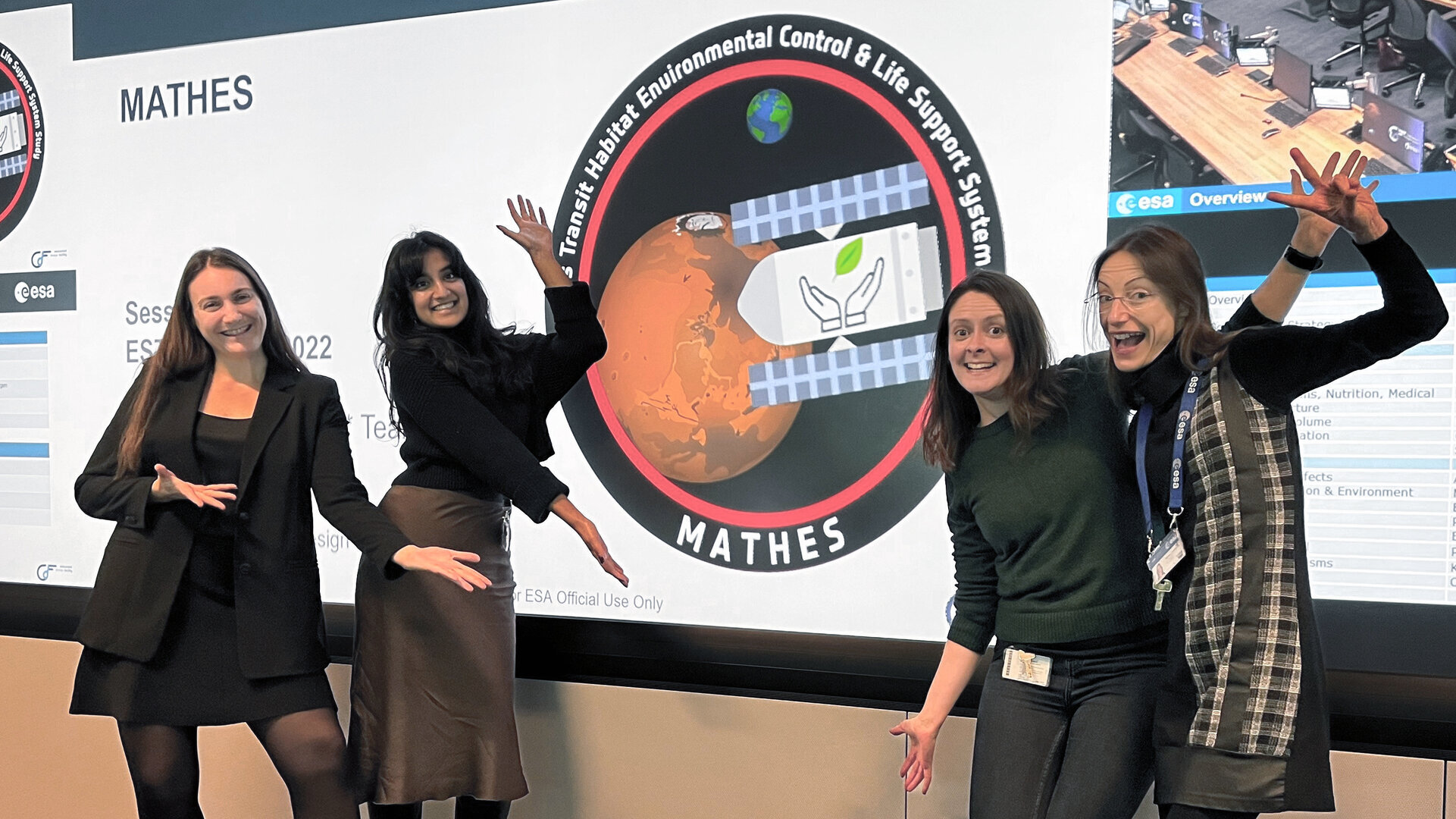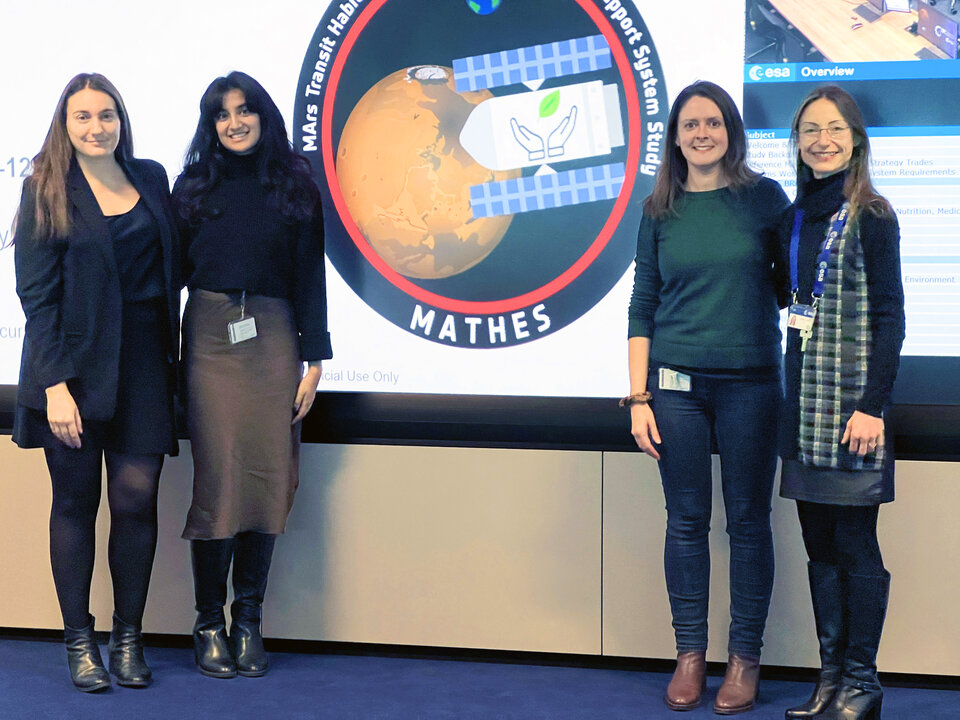11.02.2023

ESA celebrates the International Day of Women and Girls in Science this 11 February, and highlights the story of the first all-female Systems Team in ESA’s Concurrent Design Facility, the place where ideas for new space missions, systems and structures take definite shape.
Meet the team behind the Mars Transit Habitat study that will be the backbone for sustainable roundtrips to Mars.
They work in the Concurrent Design Facility (CDF), a state-of-the-art facility at ESA’s ESTEC establishment in the Netherlands. Equipped with a network of computers, multimedia devices and software tools, teams of experts from several disciplines can apply the concurrent engineering method to the design of future space missions.

The CDF’s infrastructure and processes allow engineers and scientists with diverse multidisciplinary backgrounds to work in close coordination – pulling together competences, creativity and ideas. This approach means that solutions to design challenges can be shaped in a few weeks rather than months!
The CDF’s first all-female Systems Team is involved in the ‘MATHES’ study, standing for Mars Transit Habitat Environmental Control and Life Support Systems and Crew Habitation Systems.
In our interviews below, they share their insights on ESA’s CDF and concurrent design, and we discover all about the missions they’ve worked on (click on the links).
Ilaria Roma, Head of System & Concurrent Engineering Section
Claire Parfitt, Systems Team Leader
Beatriz Sánchez De La Villa, Systems Engineer
Tatjana Mandil, Assistant Systems Engineer
+++
In focus: International Day of Women and Girls in Science
Taking on the greatest challenges currently facing the global community will mean harnessing all talent. As the world continues to grapple with COVID-19 and the critically important climate crisis, the full and equal participation and leadership of women and girls in the science and technology communities is more important than ever. Now is the time to recognize women’s contributions in research and innovation, smash stereotypes and defeat discrimination against women and girls in science.
Globally, only 33 per cent of researchers are women, and they are awarded less research funding than men, and are less likely to be promoted. In the private sector too, women are less present in company leadership and in technical roles in tech industries. Women account for just 22 per cent of professionals working in artificial intelligence and 28 per cent of engineering graduates. These glaring underrepresentations limit our ability to find inclusive, sustainable solutions to modern problems and build a better society for all.
Last year, at the Generation Equality Forum, the Action Coalition on Technology and Innovation was launched, bringing together governments, private sector companies, the UN system and civil society in order to make concrete commitments to women and girls in STEM. By 2026, the Action Coalition aims to double the proportion of women working in technology and innovation, and ensure that women and girls participate fully in finding solutions to the largest and most complex problems of our lives.
Join us on International Day of Women and Girls in Science, 11 February, as we call for women’s full and equal access to and participation in science, and celebrate those that are leading action and innovation around the world.
Joint message from Ms Sima Bahous, Executive Director of UN Women and Ms Audrey Azoulay, Director-General of UNESCO
In a joint statement for the International Day of Women and Girls in Science, UN Women Executive Director Sima Bahous and UNESCO Director-General Audrey Azoulay call to put the principle of equality into action so that science works for women.
+++
Joint message from Ms Sima Bahous, Executive Director of UN Women and Ms Audrey Azoulay, Director-General of UNESCO on the occasion of the International Day of Women and Girls in Science, 11 February
Promoting women in science to reach our full potential
The major challenges the world faces today, from COVID-19 to climate change, need our brightest scientific minds to solve them. However, only one in three scientists is a woman. This glaring disparity does not just hamstring our ability to find solutions to our common challenges, it keeps us from building the societies we need. And the disparity is systemic.
Women also remain underrepresented among senior scientists in academia. According to the 2021 UNESCO Science Report, they are awarded less research funding than men, and are less likely to be promoted. In the private sector too, women are less present in company leadership and in technical roles in tech industries. The lack of equal opportunities in the workplace is driving women out of research professions.
We must put the principle of equality into action so that science works for women, because it works against them all too often – for example, when algorithms perpetuate the biases of their programmers. Despite a labour shortage in this field, studies have shown that women account for just 22% of professionals working in artificial intelligence and 28 per cent of engineering graduates. And when they found their own start-ups, women receive less than 3 per cent of total venture capital compared to men.
The first step to change this is to provide more opportunities in science and innovation to women. That is why UNESCO and UN Women strive to get girls into science education, and to ensure their rightful place in these professions and industries.
Last year, the Generation Equality Forum launched the Action Coalition on Technology and Innovation for Gender Equality. Its aim is to double the proportion of women working in technology and innovation by 2026 and ensure that women and girls participate fully in finding solutions to the large, complex and interdisciplinary problems we face. Doing that requires positive remedies for increased representation, as well as constant vigilance to uproot long-standing discrimination and unconscious bias.
We are already seeing how working together across the public and private sectors and across generations can bring about positive change, such as by eliminating gender stereotypes in education and putting policies in place to attract and support women scientists in the workforce.
Science derives from the universal curiosity that makes us human, asking the questions that are common to us all. We urgently need it to build more inclusive, transformative and accountable science and technology ecosystems that are free of biases and discrimination. In so doing, we will be able to accelerate the Sustainable Development Goals, and address the challenges that impact us all.
Quelle: UNESCO
